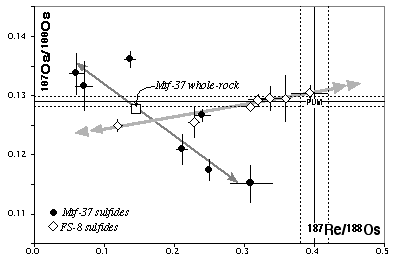Alard O.1, Griffin W.L.1,2, Lorand, J.P.3, Pearson N.J.1 and O'Reilly
S.Y1.
1. GEMOC, Macquarie university, 2. CSIRO Exploration and Mining, 3.
Laboratoire de Mineralogie, Museum National d'Histoire Naturelle, Paris,
France
The Platinum Group elements (PGE), Au and Re form a coherent group of
highly siderophile and variably chalcophile elements, which behave very
differently to lithophile elements during mantle processes providing a
different perspective on the formation and evolution of the lithospheric
mantle. In addition, the Re-Os isotopic system may provide reliable melt
depletion ages. All Together the geochemistry of the highly siderophile
elements (HSE) potentially carries large amounts of information on mantle
processes and further understanding of the evolution of the lithosphere.
However, the distribution and behavior of the HSE in the mantle is poorly
understood. Although base metal sulfides are thought to be the main host
for these elements, little attention has been paid so far to sulfide abundance,
dispersion, mineralogy and microstructural sites in mantle samples. Further
understanding of the HSE behaviour in the mantle will depend on studies
of the relationships between HSE distribution, Re/Os isotope systematics,
and the abundance and composition of sulfide phases. We have developed
in-situ techniques using Laser Ablation Microprobe facility linked to quadrupole
ICP-MS or Multicollector-ICP-MS procedure in order to further investigate
distribution of HSE (Alard et al., 2000) and variability of Os isotope
(Pearson et al., 2000) in mantle sulfides, respectively.
The main results of these studies are:
1: The extreme variability of the chondrite-normalised HSE patterns;
Pd/Ir ranges from 0.002 up to 48.
2: The high solubility of PGE in base metal sulfides (BMS); Os
and Ir contents in mono-sulfide solid solution (MSS) can be as high as
1000 ppm. These data confirm the extreme compatibilitity of such elements
in the BMS of mantle peridotites, and emphasise that the Os budget of mantle
rocks is completely controlled by the sulfide phases.
3: The HSE patterns define two groups, which display differences in
major element chemistry and microstructure. MSS enclosed in silicates show
high Os and Ir contents but low to very low Pd/Ir. The chemistry,
occurrence and HSE patterns of these enclosed sulfides suggest that they
are residual following partial melting. This type of sulfides have unradiogenic
Os isotope compositions consistent with ancient melt depletion and isolation
from the convecting asthenospheric mantle for time periods similar to the
age of the overlying crust. Enclosed sulfide as such may be find in rock
showing textural and mineralogical evidence of extensive melt/rock reactions
suggesting that the silicates have efficiently shielded the enclosed sulfide
from reaction (Burton et al., 1999). In contrast, interstitial sulfides,
which typically are lower in S but higher in Cu (e.g. Cu-rich pentlandite)
than the enclosed MSS, have low Os-Ir contents but high Pd/Ir. These sulfides
usually dominate in samples having high S contents (330 to 600 ppm), and
are interpreted as being metasomatically introduced. Their 187Os/188Os
display radiogenic values up to 0.175. and have 187Re/188Os extremely variable.
Both types of sulfide often occur in the same sample. Such samples have
normal sulfur contents (e.g. S< 200ppm). These sulfides are likely to
have been added either via volatile-rich metasomatism (eg. Mtf 37, figure
1), or through asthenosphere-lithosphere interaction as inferred for the
high-T sheared garnet-rich peridotite xenolith from Kaapvaal (eg, FS-8,
Figure 1).

Figure 1: 187Os/188Os versus 187Re/188Os for individual sulfides grains in Mtf 37 (peridotite xenolith from Montferrier, Languedoc, France) and in FS-8 garnet-rich sheared peridotite xenolith (T=1250ºC) from Frank Smith kimberlite (Kaapvaal, South Africa). PUM and Mtf37 whole-rock values are from Meisel et al., 2000.
The in-situ techniques PGE and Os isotope allow to access to crucial information on the behaviour and distribution of the HSE and on the evolution of the lithosphere (depletion/metasomatism). However care must be exercised in interpreting whole rock PGE and Re/Os data without detailed information on sulfide mineralogy and abundance. Since many of the mantle samples studied here display sulfide having both Pd-enriched and Pd-depleted patterns, radiogenic and unradiogenic 187Os/188Os we suggest that many of the whole-rock analyses reflect mixing between several sulfide generations. It is therefore hazardous to draw conclusions on earth formation and differentiation process upon PGE whole rock abundances.
REFERENCES
Alard, O., Griffin, W.L., Lorand, J.P., Jackson, S.E. and O'Reilly,
S.Y., 2000. Non-chondritic distribution of the highly siderophile elements
in mantle sulfides.Nature, Submitted.
Burton, K.W., Schiano, P., Birck, J.L., Allègre, C.J., 1999,
Osmium isotope disequilibrium between mantle minerals in a spinel-lherzolite,
Earth Planetary Science Letters, 172, 311-322.
Meisel, Th., Walker, R.J., Irving, A.J., Lorand, J.P., 2000. Osmium
isotopic composition of mantle xenoliths: A global perspective, Geochimica
Cosmochimica Acta, Submitted

 GEMOC ARC National Key Centre
GEMOC ARC National Key Centre